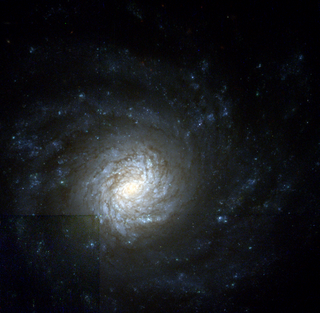
A quasar is an extremely luminous active galactic nucleus (AGN), in which a supermassive black hole with mass ranging from millions to billions of times the mass of the Sun is surrounded by a gaseous accretion disk. As gas in the disk falls towards the black hole, energy is released in the form of electromagnetic radiation, which can be observed across the electromagnetic spectrum. The power radiated by quasars is enormous: the most powerful quasars have luminosities thousands of times greater than a galaxy such as the Milky Way.

An active galactic nucleus (AGN) is a compact region at the center of a galaxy that has a much higher than normal luminosity over at least some portion of the electromagnetic spectrum with characteristics indicating that the luminosity is not produced by stars. Such excess non-stellar emission has been observed in the radio, microwave, infrared, optical, ultra-violet, X-ray and gamma ray wavebands. A galaxy hosting an AGN is called an "active galaxy." The non-stellar radiation from an AGN is theorized to result from the accretion of matter by a supermassive black hole at the center of its host galaxy.

A supermassive black hole is the largest type of black hole, containing a mass of the order of hundreds of thousands to billions of times the mass of the Sun (M☉). Black holes are a class of astronomical object that have undergone gravitational collapse, leaving behind spheroidal regions of space from which nothing can escape, not even light. Observational evidence indicates that nearly all large galaxies contain a supermassive black hole, located at the galaxy's center. In the case of the Milky Way, the supermassive black hole corresponds to the location of Sagittarius A* at the Galactic Core. Accretion of interstellar gas onto supermassive black holes is the process responsible for powering quasars and other types of active galactic nuclei.

A blazar is an active galactic nucleus (AGN) with a relativistic jet directed very nearly towards an observer. Relativistic beaming of electromagnetic radiation from the jet makes blazars appear much brighter than they would be if the jet were pointed in a direction away from the Earth. Blazars are powerful sources of emission across the electromagnetic spectrum and are observed to be sources of high-energy gamma ray photons. Blazars are highly variable sources, often undergoing rapid and dramatic fluctuations in brightness on short timescales. Some blazar jets exhibit apparent superluminal motion, another consequence of material in the jet traveling toward the observer at nearly the speed of light.

Halton Christian "Chip" Arp was an American astronomer. He was known for his 1966 Atlas of Peculiar Galaxies, which catalogues many examples of interacting and merging galaxies, though Arp disputed the idea, claiming apparent associations were prime examples of ejections. Arp was also known as a critic of the Big Bang theory and for advocating a non-standard cosmology incorporating intrinsic redshift.

A mass deficit is the amount of mass that has been removed from the center of a galaxy, presumably by the action of a binary supermassive black hole.
An astrophysical jet is an astronomical phenomenon where outflows of ionised matter are emitted as an extended beam along the axis of rotation. When this greatly accelerated matter in the beam approaches the speed of light, astrophysical jets become relativistic jets as they show effects from special relativity.

NGC 5548 is a Type I Seyfert galaxy with a bright, active nucleus. This activity is caused by matter flowing onto a 65 million solar mass (M☉) supermassive black hole at the core. Morphologically, this is an unbarred lenticular galaxy with tightly-wound spiral arms, while shell and tidal tail features suggest that it has undergone a cosmologically-recent merger or interaction event. NGC 5548 is approximately 245 million light years away and appears in the constellation Boötes. The apparent visual magnitude of NGC 5548 is approximately 13.3 in the V band.
OJ 287 is a BL Lac object located 3.5 billion light-years away that has produced quasi-periodic optical outbursts going back approximately 120 years, as first apparent on photographic plates from 1891. It has been seen on photographic plates since at least 1887. It was first detected at radio wavelengths during the course of the Ohio Sky Survey.

X-shapedradio galaxies are a class of extragalactic radio source that exhibit two, low-surface-brightness radio lobes oriented at an angle to the active, or high-surface-brightness, lobes. Both sets of lobes pass symmetrically through the center of the elliptical galaxy that is the source of the lobes, giving the radio galaxy an X-shaped morphology as seen on radio maps.
The Sołtan argument is an astrophysical theory outlined in 1982 by Polish astronomer Andrzej Sołtan. It maintains that if quasars were powered by accretion onto a supermassive black hole, then such supermassive black holes must exist in our local universe as "dead" quasars.
A hypercompact stellar system (HCSS) is a dense cluster of stars around a supermassive black hole that has been ejected from the center of its host galaxy. Stars that are close to the black hole at the time of the ejection will remain bound to the black hole after it leaves the galaxy, forming the HCSS.

NGC 3783 is a barred spiral galaxy located about 135 million light years away in the constellation Centaurus. It is inclined by an angle of 23° to the line of sight from the Earth along a position angle of about 163°. The morphological classification of SBa indicates a bar structure across the center (B) and tightly-wound spiral arms (a). Although not shown by this classification, observers note the galaxy has a luminous inner ring surrounding the bar structure. The bright compact nucleus is active and categorized as a Seyfert 1 type. This nucleus is a strong source of X-ray emission and undergoes variations in emission across the electromagnetic spectrum.

S5 0014+81 is a distant, compact, hyperluminous, broad-absorption-line quasar, or blazar, located near the high declination region of the constellation Cepheus, near the North Equatorial Pole.

NGC 4041 is the New General Catalogue identifier for a spiral galaxy in the northern circumpolar constellation of Ursa Major. It is located an estimated 70 million light years from the Sun. The morphological classification of SA(rs)bc indicates this is a spiral galaxy the lacks a bar; the 'rs' means it has a weakly-formed ring structure, and the 'bc' indicates the spiral arms are moderately to loosely wound.

Abell 1201 BGC is a massive elliptical galaxy residing as the brightest cluster galaxy of the Abell 1201 galaxy cluster. At a redshift of 0.169, this system is around 2.7 billion light years from Earth, and offset about 11 kiloparsecs from the X-ray peak of the intracluster gas. With an ellipticity of 0.32±0.02, the stellar distribution is far from spherical. In solar units, the total stellar luminosity is 4×1011 L☉ in SDSS r-band, and 1.6×1012 L☉ in 2MASS K-band. Half the stars orbit within an effective radius of 15 kpc, and their central velocity dispersion is about 285 km s−1 within 5 kpc rising to 360 km s−1 at 20 kpc distance.

NGC 7213 is a lenticular galaxy located in the constellation Grus. It is located at a distance of circa 70 million light years from Earth, which, given its apparent dimensions, means that NGC 7213 is about 75,000 light years across. It was discovered by John Herschel on September 30, 1834. It is an active galaxy with characteristics between a type I Seyfert galaxy and LINER.
![]()













